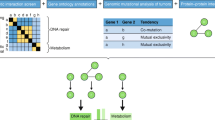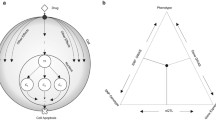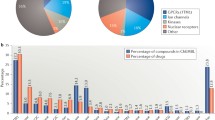Abstract
The combination of model organisms and comprehensive genome-wide screens has provided a wealth of data into the structure and regulation of the genome, gene–environment interactions, and more recently, into the mechanism of action of human therapeutics. The success of these studies relies, in part, on the ability to quantify the combined effects of multifactorial biological interactions. In this review, we explore the history and rationale behind genetic and chemical–genetic interactions with an emphasis on the phenomena of drug synergy and then briefly describe the theoretical models that we can leverage to investigate the synergy between compounds. In addition to reviewing the literature, we also provide a reference list including many of the most important studies in this field. The concept of chemical genetics interactions derives from classical studies of synthetic lethality and functional genomics. These techniques have recently graduated from the research lab to the clinic, and a better understanding of the basic principles can help accelerate this translation.
Access this chapter
Tax calculation will be finalised at checkout
Purchases are for personal use only
Similar content being viewed by others
Abbreviations
- AIDS:
-
Acquired immunodeficiency syndrome
- AML:
-
Acute myeloid leukemia
- BarSeq:
-
Barcode sequencing
- DSB:
-
Double-strand break
- HGP:
-
Human Genome Project
- HIP:
-
Haplo-insufficiency profiling
- HOP:
-
Homozygous profiling
- HSA:
-
Highest-single agent
- MIC:
-
Minimal inhibitory concentrations
- RB-TnSeq:
-
Random bar code transposon-site sequencing
- SAR:
-
Structure–activity-relationships
- Sc:
-
Saccharomyces cerevisiae
- SGA:
-
Synthetic genetic arrayTnSeq Transposon mutagenesis coupled to next-generation sequencing
- YKO:
-
Yeast knockout
References
Bridges CB (1922) The origin of variations in sexual and sex-limited characters. Am Nat 56:51–63. https://doi.org/10.1086/279847
Hartwell LH, Szankasi P, Roberts CJ et al (1997) Integrating genetic approaches into the discovery of anticancer drugs. Science 278:1064–1068. https://doi.org/10.1126/science.278.5340.1064
Hanahan D, Weinberg RA (2011) Hallmarks of cancer: the next generation. Cell 144:646–674. https://doi.org/10.1016/j.cell.2011.02.013
Darling ES, Côté IM (2008) Quantifying the evidence for ecological synergies. Ecol Lett 11:1278–1286. https://doi.org/10.1111/j.1461-0248.2008.01243.x
Piggott JJ, Townsend CR, Matthaei CD (2015) Reconceptualizing synergism and antagonism among multiple stressors. Ecol Evol 5:1538–1547. https://doi.org/10.1002/ece3.1465
Tang J, Wennerberg K, Aittokallio T (2015) What is synergy? The Saariselkä agreement revisited. Front Pharmacol 6:181. https://doi.org/10.3389/fphar.2015.00181
Cokol M, Chua HN, Tasan M et al (2011) Systematic exploration of synergistic drug pairs. Mol Syst Biol 7:544. https://doi.org/10.1038/msb.2011.71
Miller ML, Molinelli EJ, Nair JS et al (2013) Drug synergy screen and network modeling in dedifferentiated Liposarcoma identifies CDK4 and IGF1R as synergistic drug targets. Sci Signal 6:ra85. https://doi.org/10.1126/scisignal.2004014
Torres NP, Lee AY, Giaever G et al (2013) A high-throughput yeast assay identifies synergistic drug combinations. Assay Drug Dev Technol 11:299–307. https://doi.org/10.1089/adt.2012.503
Azmi AS, Wang Z, Philip PA et al (2010) Proof of concept: network and systems biology approaches aid in the discovery of potent anticancer drug combinations. Mol Cancer Ther 9:3137–3144. https://doi.org/10.1158/1535-7163.MCT-10-0642
Chou T-C (2006) Theoretical basis, experimental design, and computerized simulation of synergism and antagonism in drug combination studies. Pharmacol Rev 58:621–681. https://doi.org/10.1124/pr.58.3.10
Chabner BA, Roberts TG (2005) Chemotherapy and the war on cancer. Nat Rev Cancer 5:65–72. https://doi.org/10.1038/nrc1529
Spain L, Julve M, Larkin J (2016) Combination dabrafenib and trametinib in the management of advanced melanoma with BRAFV600 mutations. Expert Opin Pharmacother 17:1031–1038. https://doi.org/10.1517/14656566.2016.1168805
Frei Emil III, Holland JF, Schneiderman MA et al (1958) A comparative study of two regimens of combination chemotherapy in acute leukemia. Blood 13:1126–1148. https://doi.org/10.1182/blood.V13.12.1126.1126
Bredel M, Jacoby E (2004) Chemogenomics: an emerging strategy for rapid target and drug discovery. Nat Rev Genet 5:262–275. https://doi.org/10.1038/nrg1317
Chandrasekaran S, Cokol-Cakmak M, Sahin N et al (2016) Chemogenomics and orthology-based design of antibiotic combination therapies. Mol Syst Biol 12:872. https://doi.org/10.15252/msb.20156777
Cokol M, Li C, Chandrasekaran S (2019) Chemogenomic model identifies synergistic drug combinations robust to the pathogen microenvironment. PLoS Comput Biol 14:1–24. https://doi.org/10.1371/journal.pcbi.1006677
Zewail A, Xie MW, Xing Y et al (2003) Novel functions of the phosphatidylinositol metabolic pathway discovered by a chemical genomics screen with wortmannin. Proc Natl Acad Sci 100:3345–3350. https://doi.org/10.1073/pnas.0530118100
Kwon Y, Cha J, Chiang J et al (2016) A chemogenomic approach to understand the antifungal action of lichen-derived vulpinic acid. J Appl Microbiol 121:1580–1591. https://doi.org/10.1111/jam.13300
Jaime MDLA, Lopez-Llorca LV, Conesa A et al (2012) Identification of yeast genes that confer resistance to chitosan oligosaccharide (COS) using chemogenomics. BMC Genomics 13:267. https://doi.org/10.1186/1471-2164-13-267
Balmus G, Barros AC, Wijnhoven PWG et al (2016) Synthetic lethality between PAXX and XLF in mammalian development. Genes Dev 30:2152–2157. https://doi.org/10.1101/gad.290510.116
Caffrey CR, Rohwer A, Oellien F et al (2009) A comparative Chemogenomics strategy to predict potential drug targets in the metazoan pathogen, Schistosoma mansoni. PLoS One 4:1–7. https://doi.org/10.1371/journal.pone.0004413
Custodia N, Won SJ, Novillo A et al (2001) Caenorhabditis elegans as an environmental monitor using DNA microarray analysis. Ann N Y Acad Sci 948:32–42. https://doi.org/10.1111/j.1749-6632.2001.tb03984.x
Reichert K, Menzel R (2005) Expression profiling of five different xenobiotics using a Caenorhabditis elegans whole genome microarray. Chemosphere 61:229–237. https://doi.org/10.1016/j.chemosphere.2005.01.077
Lam SH, Mathavan S, Tong Y et al (2008) Zebrafish whole-adult-organism Chemogenomics for large-scale predictive and discovery chemical biology. PLoS Genet 4:1–14. https://doi.org/10.1371/journal.pgen.1000121
Cowell AN, Istvan ES, Lukens AK et al (2018) Mapping the malaria parasite druggable genome by using in vitro evolution and chemogenomics. Science 359:191–199. https://doi.org/10.1126/science.aan4472
Smith V, Botstein D, Brown PO (1995) Genetic footprinting: a genomic strategy for determining a gene’s function given its sequence. Proc Natl Acad Sci U S A 92:6479–6483. https://doi.org/10.1073/pnas.92.14.6479
Wölcke J, Ullmann D (2001) Miniaturized HTS technologies—uHTS. Drug Discov Today 6:637–646. https://doi.org/10.1016/S1359-6446(01)01807-4
Stockwell BR, Haggarty SJ, Schreiber SL (1999) High-throughput screening of small molecules in miniaturized mammalian cell-based assays involving post-translational modifications. Chem Biol 6:71–83. https://doi.org/10.1016/S1074-5521(99)80004-0
Stockwell BR (2000) Chemical genetics: ligand-based discovery of gene function. Nat Rev Genet 1:116–125. https://doi.org/10.1038/35038557
Stockwell BR (2000) Frontiers in chemical genetics. Trends Biotechnol 18:449–455. https://doi.org/10.1016/S0167-7799(00)01499-2
Giaever G, Chu AM, Ni L et al (2002) Functional profiling of the Saccharomyces cerevisiae genome. Nature 418:387–391. https://doi.org/10.1038/nature00935
Dolma S, Lessnick SL, Hahn WC et al (2003) Identification of genotype-selective antitumor agents using synthetic lethal chemical screening in engineered human tumor cells. Cancer Cell 3:285–296. https://doi.org/10.1016/S1535-6108(03)00050-3
Kwon H (2003) Chemical genomics-based target identification and validation of anti-angiogenic agents. Curr Med Chem 10:717–726. https://doi.org/10.2174/0929867033457755
Lee AY, St.Onge RP, Proctor MJ et al (2014) Mapping the cellular response to small molecules using Chemogenomic fitness signatures. Science 344:208–211. https://doi.org/10.1126/science.1250217
Tong AHY, Lesage G, Bader GD et al (2004) Global mapping of the yeast genetic interaction network. Science 303:808 LP–813 LP. https://doi.org/10.1126/science.1091317
Davierwala AP, Haynes J, Li Z et al (2005) The synthetic genetic interaction spectrum of essential genes. Nat Genet 37:1147–1152. https://doi.org/10.1038/ng1640
Boone C, Bussey H, Andrews BJ (2007) Exploring genetic interactions and networks with yeast. Nat Rev Genet 8:437–449. https://doi.org/10.1038/nrg2085
Costanzo M, Baryshnikova A, VanderSluis B et al (2013) Genetic networks. In: Handbook of systems biology. Elsevier, Amsterdam, pp 115–135
Fisher RA (1919) The correlation between relatives on the supposition of Mendelian inheritance. Trans R Soc Edinburgh 52:399–433. https://doi.org/10.1017/S0080456800012163
Guarente L (1993) Synthetic enhancement in gene interaction: a genetic tool come of age. Trends Genet 9:362–366. https://doi.org/10.1016/0168-9525(93)90042-G
Bender A, Pringle JR (1991) Use of a screen for synthetic lethal and multicopy suppressee mutants to identify two new genes involved in morphogenesis in Saccharomyces cerevisiae. Mol Cell Biol 11:1295 LP–1305 LP. https://doi.org/10.1128/MCB.11.3.1295
Mani R, St.Onge RP, Hartman JL et al (2008) Defining genetic interaction. Proc Natl Acad Sci U S A 105:3461 LP–3466 LP. https://doi.org/10.1073/pnas.0712255105
Novick P, Botstein D (1985) Phenotypic analysis of temperature-sensitive yeast actin mutants. Cell 40:405–416. https://doi.org/10.1016/0092-8674(85)90154-0
Tong AHY, Evangelista M, Parsons AB et al (2001) Systematic genetic analysis with ordered arrays of yeast deletion mutants. Science 294:2364–2368. https://doi.org/10.1126/science.1065810
Onge RPS, Mani R, Oh J et al (2007) Systematic pathway analysis using high-resolution fitness profiling of combinatorial gene deletions. Nat Genet 39:199–206. https://doi.org/10.1038/ng1948
Drees BL, Thorsson V, Carter GW et al (2005) Derivation of genetic interaction networks from quantitative phenotype data. Genome Biol 6:R38. https://doi.org/10.1186/gb-2005-6-4-r38
Kuzmin E, VanderSluis B, Nguyen Ba AN et al (2020) Exploring whole-genome duplicate gene retention with complex genetic interaction analysis. Science 368. https://doi.org/10.1126/science.aaz5667
Silberberg Y, Kupiec M, Sharan R (2016) Utilizing yeast chemogenomic profiles for the prediction of pharmacogenomic associations in humans. Sci Rep 6:23703. https://doi.org/10.1038/srep23703
Lee AY, Bader GD, Nislow C et al (2013) Chemogenomic profiling. In: Handbook of systems biology. Elsevier, Amsterdam, pp 153–176
Goffeau A, Barrell BG, Bussey H et al (1996) Life with 6000 genes. Science 274:546–567. https://doi.org/10.1126/science.274.5287.546
Wach A, Brachat A, Pöhlmann R et al (1994) New heterologous modules for classical or PCR-based gene disruptions in Saccharomyces cerevisiae. Yeast 10:1793–1808. https://doi.org/10.1002/yea.320101310
Pierce SE, Davis RW, Nislow C et al (2009) Chemogenomic approaches to elucidation of gene function and genetic pathways. In: Stagljar I (ed) Yeast functional genomics and proteomics: methods and protocols. Humana Press, Totowa, NJ, pp 115–143
Giaever G, Shoemaker DD, Jones TW et al (1999) Genomic profiling of drug sensitivities via induced haploinsufficiency. Nat Genet 21:278–283. https://doi.org/10.1038/6791
Nislow C, Giaever G (2007) Chapter 17 - chemical genomic tools for understanding gene function and drug action. In: Stansfield I, Stark MJR (eds) Yeast Gene Analysis. Academic Press, Cambridge, Massachusetts, pp 387–709
Giaever G, Flaherty P, Kumm J et al (2004) Chemogenomic profiling: identifying the functional interactions of small molecules in yeast. Proc Natl Acad Sci U S A 101:793–798. https://doi.org/10.1073/pnas.0307490100
Pierce SE, Davis RW, Nislow C et al (2007) Genome-wide analysis of barcoded Saccharomyces cerevisiae gene-deletion mutants in pooled cultures. Nat Protoc 2:2958–2974. https://doi.org/10.1038/nprot.2007.427
Stockwell BR (2004) Exploring biology with small organic molecules. Nature 432:846–854. https://doi.org/10.1038/nature03196
Lehár J, Stockwell BR, Giaever G et al (2008) Combination chemical genetics. Nat Chem Biol 4:674–681. https://doi.org/10.1038/nchembio.120
Rine J, Hansen W, Hardeman E et al (1983) Targeted selection of recombinant clones through gene dosage effects. Proc Natl Acad Sci U S A 80:6750–6754. https://doi.org/10.1073/pnas.80.22.6750
Colic M, Hart T (2019) Chemogenetic interactions in human cancer cells. Comput Struct Biotechnol J 17:1318–1325. https://doi.org/10.1016/j.csbj.2019.09.006
Kellis M, Patterson N, Endrizzi M et al (2003) Sequencing and comparison of yeast species to identify genes and regulatory elements. Nature 423:241–254. https://doi.org/10.1038/nature01644
Botstein D, Chervitz SA, Cherry M (1997) Yeast as a model organism. Science 277:1259–1260. https://doi.org/10.1126/science.277.5330.1259
Luesch H, Wu TYH, Ren P et al (2005) A genome-wide overexpression screen in yeast for small-molecule target identification. Chem Biol 12:55–63. https://doi.org/10.1016/j.chembiol.2004.10.015
Sherman F (2002) Getting started with yeast. In: Guthrie C, Fink GR (eds) Guide to Yeast Genetics and Molecular and Cell Biology - Part B. Academic Press, Cambridge, Massachusetts, pp 3–41
Hammond TG, Birdsall HH (2019) Yeast in space. In: Handbook of Space Pharmaceuticals. Springer, Berlin, pp 1–16
Lee W, St.Onge RP, Proctor M et al (2005) Genome-wide requirements for resistance to functionally distinct DNA-damaging agents. PLoS Genet 1:e24. https://doi.org/10.1371/journal.pgen.0010024
Brown JA, Sherlock G, Myers CL et al (2006) Global analysis of gene function in yeast by quantitative phenotypic profiling. Mol Syst Biol 2:2006.0001. https://doi.org/10.1038/msb4100043
Hoon S, St.Onge RP, Giaever G et al (2008) Yeast chemical genomics and drug discovery: an update. Trends Pharmacol Sci 29:499–504. https://doi.org/10.1016/j.tips.2008.07.006
Škrtić M, Sriskanthadevan S, Jhas B et al (2011) Inhibition of mitochondrial translation as a therapeutic strategy for human acute myeloid leukemia. Cancer Cell 20:674–688. https://doi.org/10.1016/j.ccr.2011.10.015
Sharma SV, Agatsuma T, Nakano H (1998) Targeting of the protein chaperone, HSP90, by the transformation suppressing agent, radicicol. Oncogene 16:2639–2645. https://doi.org/10.1038/sj.onc.1201790
Pries V, Nöcker C, Khan D et al (2018) Target identification and mechanism of action of Picolinamide and Benzamide Chemotypes with antifungal properties. Cell Chem Biol 25:279–290.e7. https://doi.org/10.1016/j.chembiol.2017.12.007
Wetmore KM, Price MN, Waters RJ et al (2015) Rapid quantification of mutant fitness in diverse bacteria by sequencing randomly Bar-coded transposons. MBio 6:1–15. https://doi.org/10.1128/mBio.00306-15
Alfred SE, Surendra A, Le C et al (2012) A phenotypic screening platform to identify small molecule modulators of Chlamydomonas reinhardtiigrowth, motility and photosynthesis. Genome Biol 13:R105. https://doi.org/10.1186/gb-2012-13-11-r105
Avasthi P, Marley A, Lin H et al (2012) A chemical screen identifies class A G-protein coupled receptors as regulators of cilia. ACS Chem Biol 7:911–919. https://doi.org/10.1021/cb200349v
Chen YH, Ge CL, Wang H et al (2018) GCY-35/GCY-36—TAX-2/TAX-4 Signalling in O2 sensory neurons mediates acute functional ethanol tolerance in Caenorhabditis elegans. Sci Rep 8:3020. https://doi.org/10.1038/s41598-018-20477-z
Westphal M, Sant P, Hauser AT et al (2020) Chemical genetics screen identifies epigenetic mechanisms involved in dopaminergic and noradrenergic neurogenesis in zebrafish. Front Genet 11:80. https://doi.org/10.3389/fgene.2020.00080
Bentley VL, Veinotte CJ, Corkery DP et al (2015) Focused chemical genomics using zebrafish xenotransplantation as a pre-clinical therapeutic platform for T-cell acute lymphoblastic leukemia. Haematologica 100:70–76. https://doi.org/10.3324/haematol.2014.110742
MacLeod G, Bozek DA, Rajakulendran N et al (2019) Genome-wide CRISPR-Cas9 screens expose genetic vulnerabilities and mechanisms of Temozolomide sensitivity in glioblastoma stem cells. Cell Rep 27:971–986.e9. https://doi.org/10.1016/j.celrep.2019.03.047
Estoppey D, Hewett JW, Guy CT et al (2017) Identification of a novel NAMPT inhibitor by CRISPR/Cas9 chemogenomic profiling in mammalian cells. Sci Rep 7:42728. https://doi.org/10.1038/srep42728
Hasson SA, Fogel AI, Wang C et al (2015) Chemogenomic profiling of endogenous PARK2 expression using a genome-edited coincidence reporter. ACS Chem Biol 10:1188–1197. https://doi.org/10.1021/cb5010417
Yilancioglu K, Weinstein ZB, Meydan C et al (2014) Target-independent prediction of drug synergies using only drug lipophilicity. J Chem Inf Model 54:2286–2293. https://doi.org/10.1021/ci500276x
Owens CM, Mawhinney C, Grenier JM et al (2010) Chemical combinations elucidate pathway interactions and regulation relevant to hepatitis C replication. Mol Syst Biol 6:375. https://doi.org/10.1038/msb.2010.32
Lehár J, Krueger AS, Avery W et al (2009) Synergistic drug combinations tend to improve therapeutically relevant selectivity. Nat Biotechnol 27:659–666. https://doi.org/10.1038/nbt.1549
Geary N (2013) Understanding synergy. Am J Physiol Metab 304:E237–E253. https://doi.org/10.1152/ajpendo.00308.2012
Bliss CI (1939) The toxicity of poisons applied jointly. Ann Appl Biol 26:585–615. https://doi.org/10.1111/j.1744-7348.1939.tb06990.x
Loewe S (1953) The problem of synergism and antagonism of combined drugs. Arzneimittelforschung 3:285–290
Lehár J, Zimmermann GR, Krueger AS et al (2007) Chemical combination effects predict connectivity in biological systems. Mol Syst Biol 3:80. https://doi.org/10.1038/msb4100116
Foucquier J, Guedj M (2015) Analysis of drug combinations: current methodological landscape. Pharmacol Res Perspect 3:e00149. https://doi.org/10.1002/prp2.149
Goldoni M, Johansson C (2007) A mathematical approach to study combined effects of toxicants in vitro: evaluation of the Bliss independence criterion and the Loewe additivity model. Toxicol Vitr 21:759–769. https://doi.org/10.1016/j.tiv.2007.03.003
Greco WR, Bravo G, Parsons JC (1995) The search for synergy: a critical review from a response surface perspective. Pharmacol Rev 47:331–385
Bulusu KC, Guha R, Mason DJ et al (2016) Modelling of compound combination effects and applications to efficacy and toxicity: state-of-the-art, challenges and perspectives. Drug Discov Today 21:225–238. https://doi.org/10.1016/j.drudis.2015.09.003
Cokol-Cakmak M, Bakan F, Cetiner S et al (2018) Diagonal method to measure synergy among any number of drugs. J Vis Exp 2018:1–10. https://doi.org/10.3791/57713
Author information
Authors and Affiliations
Corresponding author
Editor information
Editors and Affiliations
Rights and permissions
Copyright information
© 2021 The Author(s), under exclusive license to Springer Science+Business Media, LLC, part of Springer Nature
About this protocol
Cite this protocol
Gaikani, H., Giaever, G., Nislow, C. (2021). Chemical–Genetic Interactions as a Means to Characterize Drug Synergy. In: Vizeacoumar, F.J., Freywald, A. (eds) Mapping Genetic Interactions. Methods in Molecular Biology, vol 2381. Humana, New York, NY. https://doi.org/10.1007/978-1-0716-1740-3_14
Download citation
DOI: https://doi.org/10.1007/978-1-0716-1740-3_14
Published:
Publisher Name: Humana, New York, NY
Print ISBN: 978-1-0716-1739-7
Online ISBN: 978-1-0716-1740-3
eBook Packages: Springer Protocols




